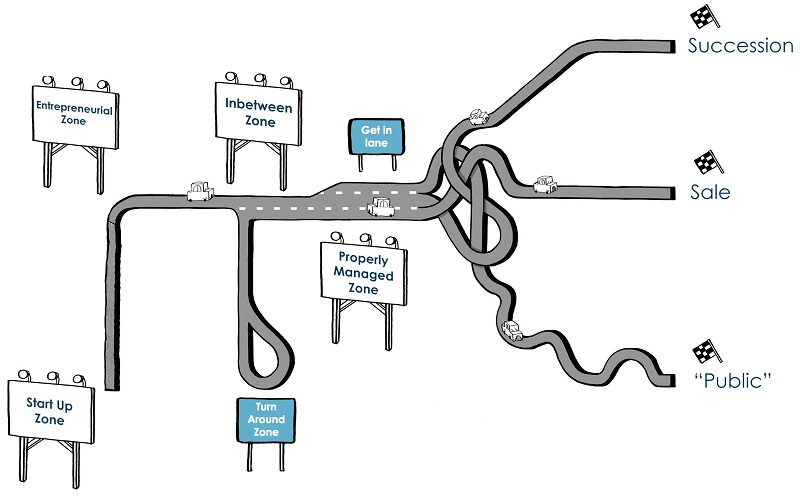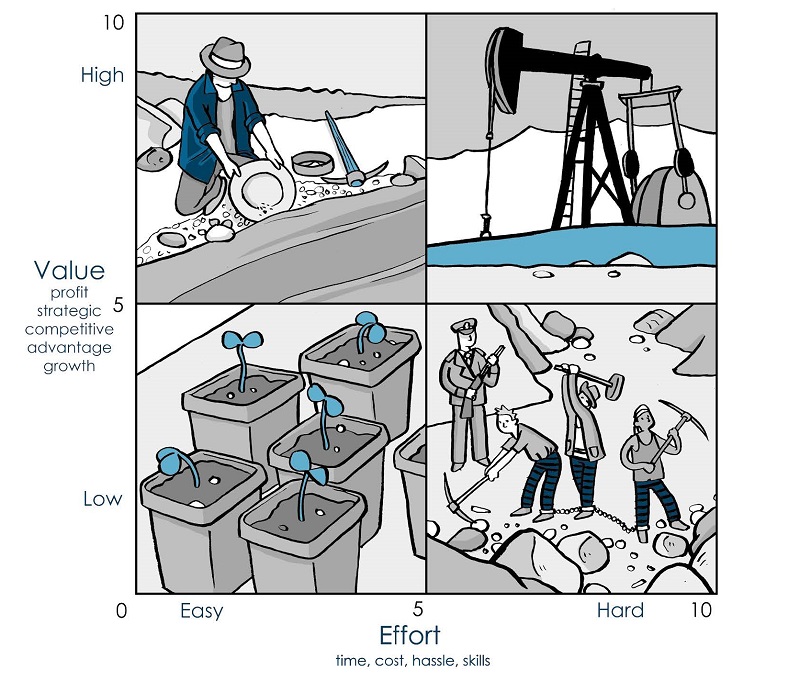You are a high-growth firm, and you have identified the need to develop your people beyond their technical capabilities. How and where do you start?
The first thing to recognize is that, as a high-growth firm today, your business will most likely be located in a place that we call the In-Between Zone. In other words, your business has transitioned beyond the purely Entrepreneurial Zone phase, but has not yet reached the Properly-Managed Zone. In fact, that’s where we find most small growing businesses with annual revenues between $1m and $20m.

That means that as the original entrepeneur you can no longer manage like Tom Brady in the huddle—more to the point, you really don’t want your young management team copying and developing your bad management habits.
A big problem is that for many years your aspiring management team has been closely watching you in action, and you are quite likely their only, or at least a major, role model.
That’s not good! Let’s think about how you work. As an entrepreneur, you are really good at spinning a number of plates. That means you usually:
- Don’t prepare in advance for management meetings. You don’t need to, because you’re an entrepreneur and can wing it, obviously!
- Don’t thoroughly brainstorm all the various possible actions. As an entrepreneur, you intuitively know what will work best and can work it out in your head while you’re watching
- Don’t properly test ideas in advance of implementing them (see entrepreneur’s intuition above).
You see the pattern? You behave like a typical entrepreneur—because that is what you are! This is the result.
What happens is that at most In-Between Zone businesses, all the following steps happen in the same meeting, more or less simultaneously. It is like watching a stream of consciousness.
Your meeting identifies a problem. The team will discuss it for maybe five minutes, maximum. Somebody, probably the entrepreneur, suggests a couple of ideas, and one of those ideas seems like it has some merit and is seized upon by the group. There is no discussion around any other possible ideas, as the team immediately zeros in on the first idea.
The team quickly moves on to discuss how to implement that idea, in a very unstructured way. The meeting is quickly bogged down by details, and we all lose focus. We end the meeting thinking we have, at least loosely, solved the problem—but nobody owns the problem. We meet up again in X days/weeks/months and discover that nothing has actually happened in the interim. We repeat the above pattern at the next meeting.
Sound familiar? You are definitely in the In-Between Zone! How can you educate and develop your team to build better growth plans?
This presents a problem. Your team is young, and they are developing their management and leadership skills. Moreover, the team will not be populated by entrepreneurial types, or they would already be running their own growing businesses. More importantly, you have plans to really grow your business. Plate-spinning is not the style you want to see in your management team.
You want to develop a properly managed business where the team is all pulling together in the same direction towards your clearly articulated business growth vision. You certainly do not want to develop a gang of entrepreneurial types all trying to copy your wing it style.
So how can we educate and develop them properly so they don’t follow your poor example?
A good place to start is to think about implementing a standard framework for building plans—and in doing so, start building good team and management habits. In other words, let’s develop a standard planning process.
Let’s start by agreeing on a standard framework for an action plan—any action plan. It looks like the illustration below and has four distinct quadrants.

The key element here is to recognize that any potential action plan always involves two big variables:
- How much value the potential action might bring, ranging from high to low—where value is based around concepts like growing profits, building competitive advantage, business value growth,
- How much effort the potential action might involve, ranging from high to low—where effort is based around concepts like time, cost, hassle, etc.
In the illustration above, the planning quadrant you always want to avoid is located bottom right. These ideas have LOW VALUE and HIGH EFFORT. We call that working on the chain gang.
All of the other quadrants have business merit; they are just different, as we explain below. Let’s take you through how we get there:
Step 1 – Develop Your Team to Brainstorm Properly
Developing teams need to be taught to brainstorm as a totally separate exercise.
That means setting proper time aside to brainstorm properly. Have a flip chart or white board and a nominated facilitator. Make sure you establish some clear rules.
The most important rule is that all ideas are captured in writing—and we don’t start discussing the merits of any ideas until we have completely exhausted all ideas.
The facilitator must try and dig deep and keep asking “why” questions (they should learn the rule of “five whys”) until we have captured several possible ideas to solve the problem.
Step 2 – Develop Your Team to Sort and Grade Their New Ideas Properly
 Use the criteria we established above, value and effort, and score each idea on a scale of 1-10 based upon the relative values and relative effort involved.
Use the criteria we established above, value and effort, and score each idea on a scale of 1-10 based upon the relative values and relative effort involved.
Remember, once that you have scored the first few ideas you will have created a benchmark for comparison, and there is always scope to go back and recalibrate the scores. Try and educate your team that not every idea is a 10 idea!
Step 3 – Develop Your Team to Plot the Scores on the Action Plan Chart
Position the new ideas within the four scoring quadrants shown in the illustration.

- Top left quadrant: HIGH VALUE / LOW EFFORT ideas. These should be your top priority actions. These ideas are where you are “panning for gold.”
- Bottom left quadrant: LOW VALUE / LOW EFFORT ideas. These are great because they are easy, provide the team with easy wins, and help create some action momentum. These ideas are the “out-of-little-acorns” type.
- Top right quadrant: HIGH VALUE / HIGH EFFORT ideas. This is where you will probably end up focusing, but you need to build proper plans (see below). These ideas are where you are “drilling for oil.“
Remember, you can’t try and do too many of these “drilling for oil” actions simultaneously, because there will likely be too much effort involved. You need to educate your developing team to adopt a sensibly balanced approach for planning for growth.
Step 4 – Develop Your Team to Prepare a Force Field Analysis
This is how you educate your developing team to build the bones of a plan using a consistent, structured, and collaborative process.
 To prepare a Force Field Analysis, you start by asking your team to identify the big positive actions that need to happen if the plan is going to work.
To prepare a Force Field Analysis, you start by asking your team to identify the big positive actions that need to happen if the plan is going to work.
List those positive ideas on the left of the illustration above.
It would be normal to expect at least 5-6 big action items in any plan. For example, in a marketing growth plan, you would need to do big things like identify what target customers look like.
Once the team have exhausted all the big, positive actions, ask them to list all the big negative forces that are going to stop the plan happening.
Usually these are things like “we don’t have time to do this”, “we don’t have some of the skills needed”, “we don’t have the resources” and so on.
Again, you would expect at least 5-6 big negative forces that are likely to hold back plan implementation.
The team should write those negative forces on the right of the illustration above.
Now get the team to go back to the positive list on the left. Under each of the 5-6 big positives, brainstorm 5 sub-actions required to drive the big action.
Similarly, go back to the negative list on the right. Under each of those 5-6 big negatives, brainstorm 5 ways we could mitigate, perhaps halve the impact, of the negative force.
In this way, a team, working collaboratively, can learn to quickly (within 1-2 hours) build an outline plan with about 50-60 agreed actions required—6 x 5 on the left side and 6 x 5 on the right side.
Those 60 actions may not comprise the whole plan, but they will cover the highlights (more than 80% of what is important) and you will have benefited from team effort and achieved a high level of team collaboration and consensus.
If you look at the illustration above, by this stage your developing team will have completed the initial Plan (Brainstorm, Scoring Matrix, Force Field) stage of Plan, Do, Test, Act.
The next stage is to Do, which means making somebody on the team accountable, with an agreed timescale, resources, etc., to put flesh on the bones of the Force Field plan.
Usually this involves bringing the fleshed-out plan back to the group at a later date for the next stage of team agreement.
Having reached that stage, the developing team can then move to Test. This is often where the initial plan is tweaked multiple times. Let them learn to really get it right before they move to implement fully.
Finally Act. Implement the plan—whatever it is.
Obviously, the details of the plan are always going to vary, but what we are beginning to do is educate and develop the team to work together in a pattern that is likely to achieve better growth results. The other benefit of a structured approach as we have illustrated is that it becomes easy to put the team under the microscope. Where is the team strong, and where is it weak? Where do we need more training and perhaps recruitment?
The team is on the way towards the Properly-Managed Zone, but remember, a journey of 1,000 miles always starts with a single step!
You need to educate and develop your team so they don’t believe that plate spinning is the only game in town!
About the Author: Paul Latham, Principal at HaydenRock Solutions
Next Steps
For resources and support as you guide your team to the “properly-managed zone,” check out HaydenRock Solutions, a Rainmaker Alliance Resource Member. The HaydenRock System™ enhances the ability of firms to offer and deliver new value-add services to grow revenue with their best clients. Additionally, Rainmaker offers the Practice Growth Team Development program in which we work with a firm’s high-potential industry niche or practice segment teams to establish clear growth strategies and action plans, ensuring that available energy and resources are directed at their highest and best use.





